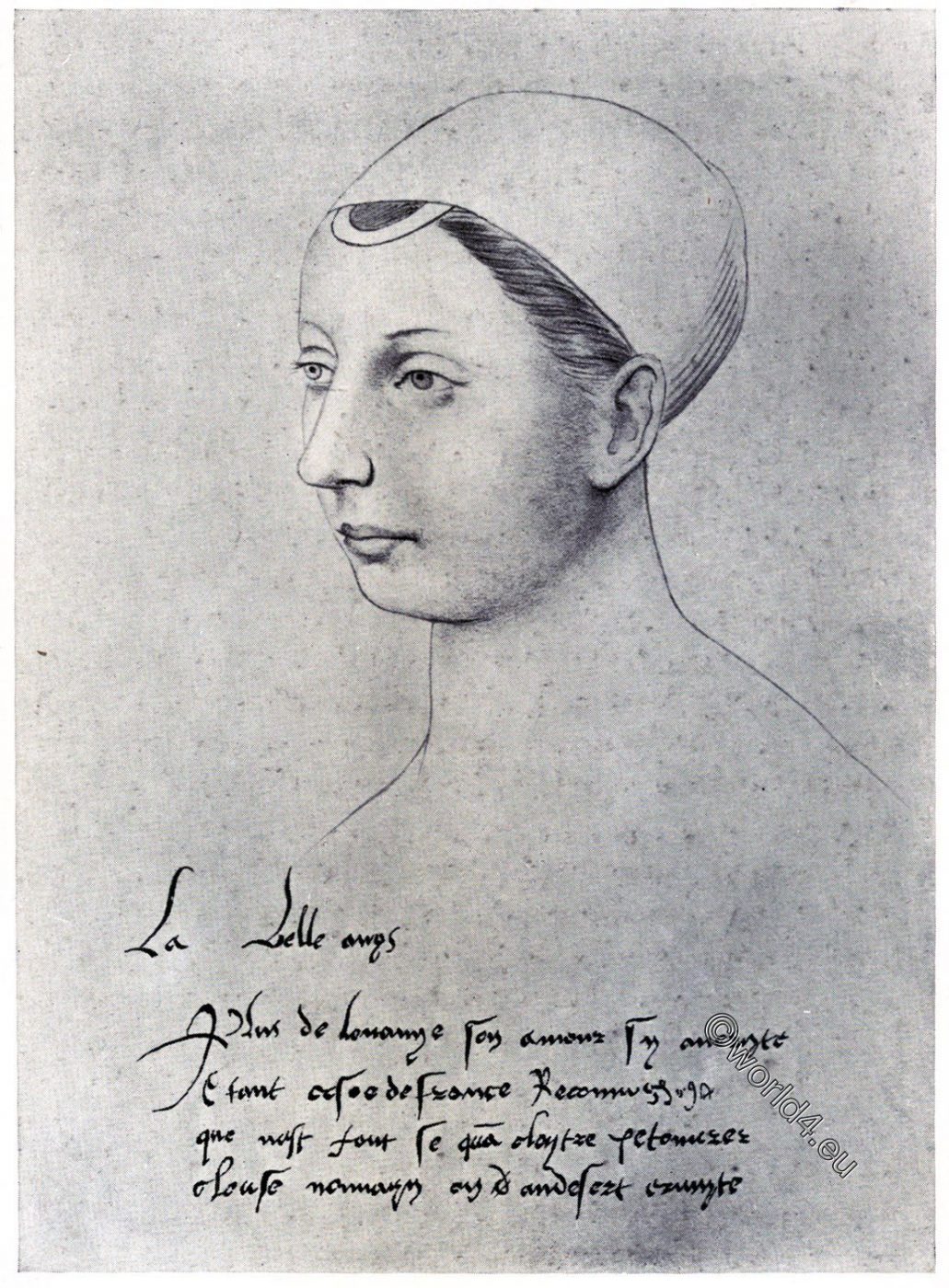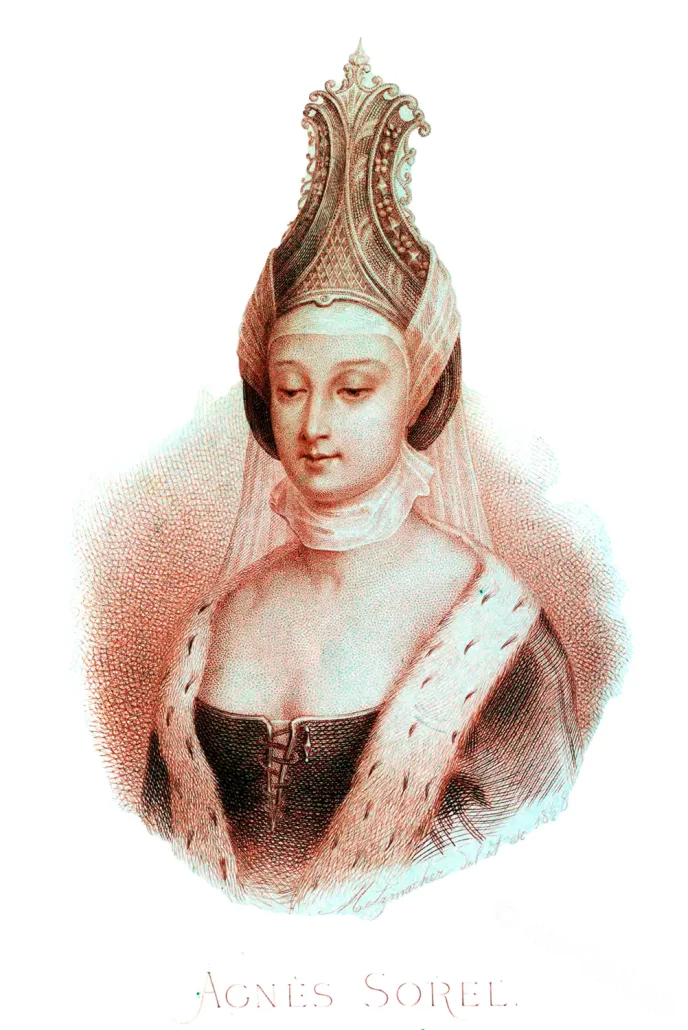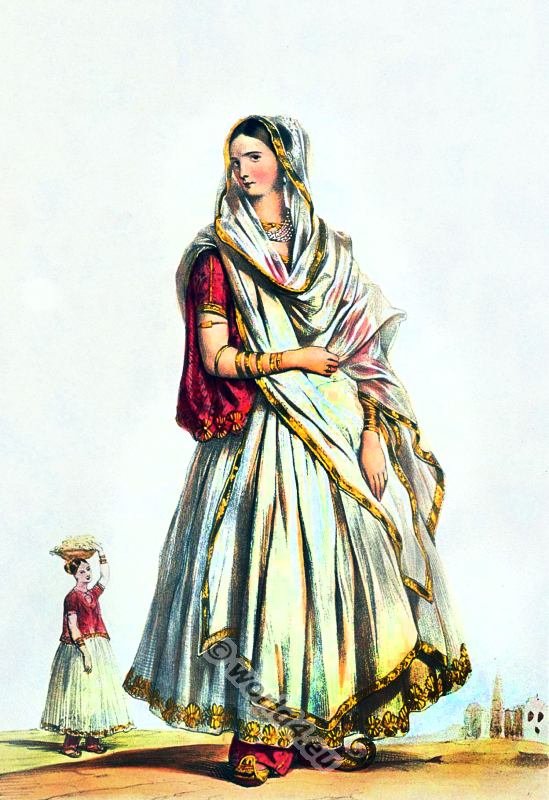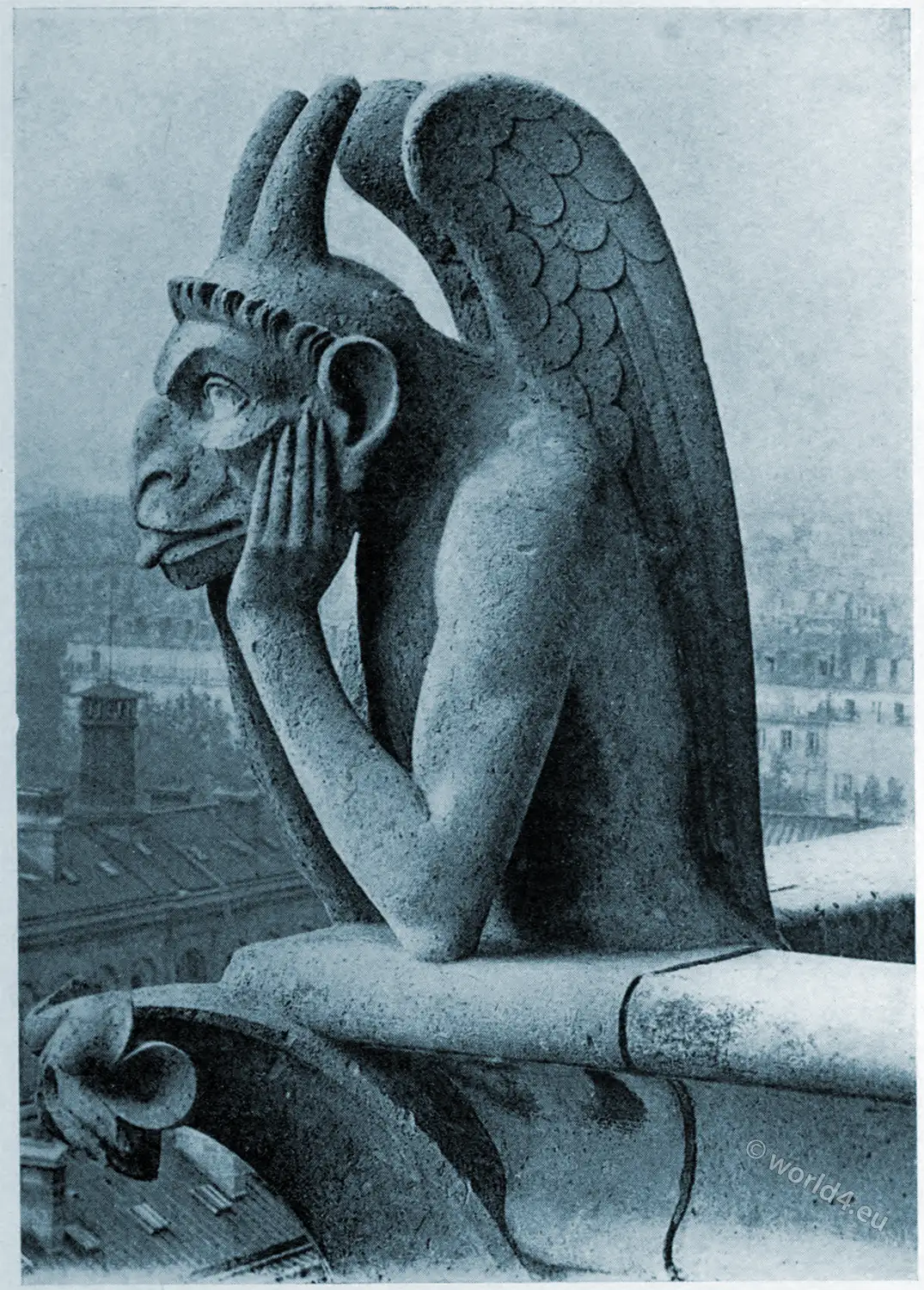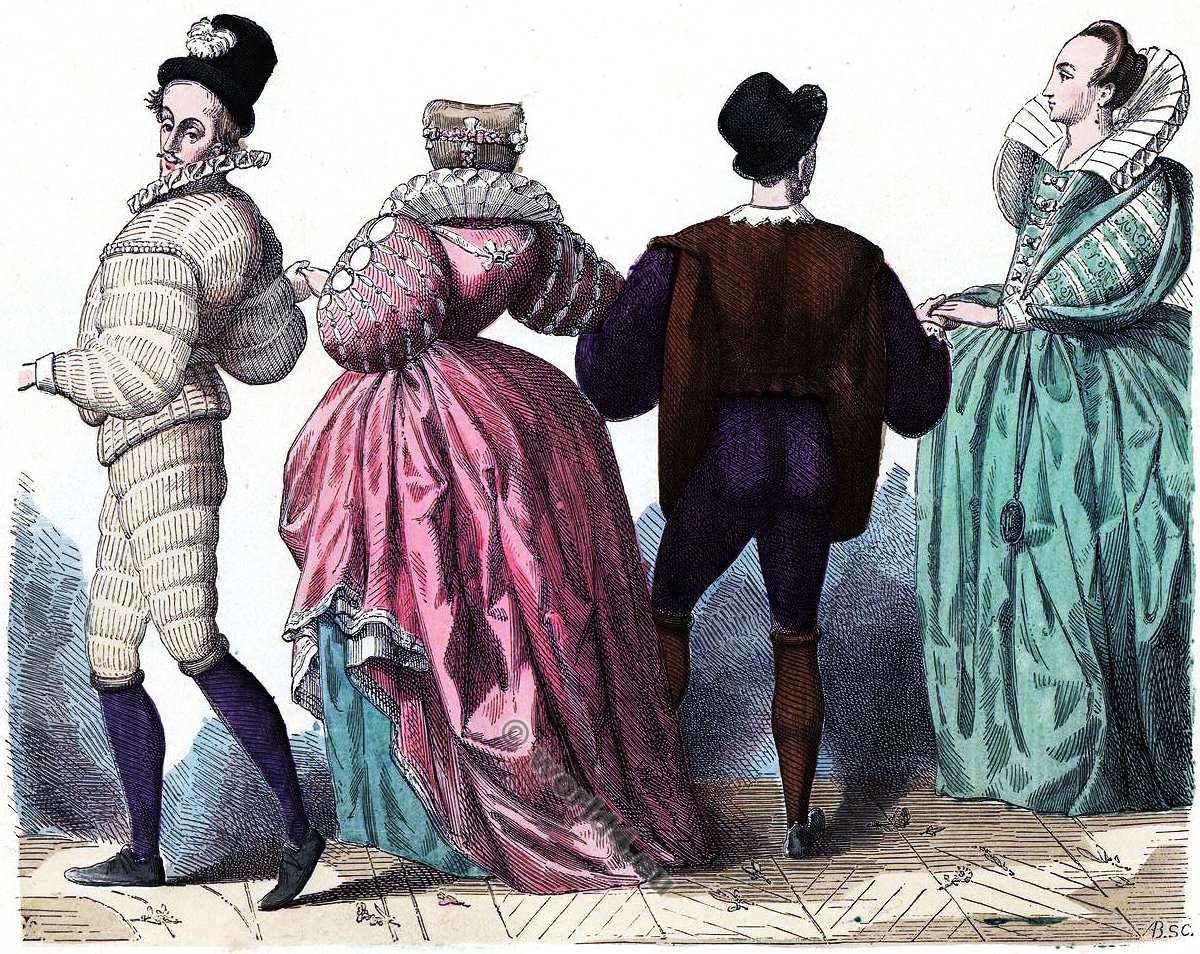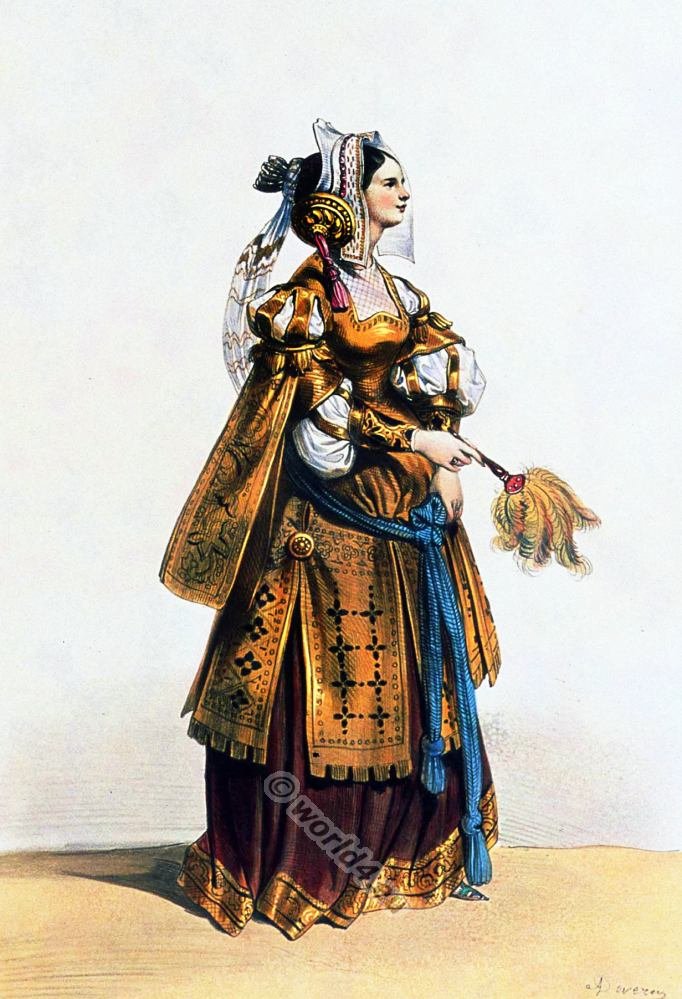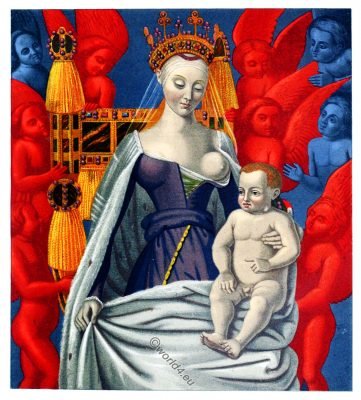
Agnès Sorel as Madonna Lactans. Right wing of the Melun Diptych. Agnès Sorel represents in Notre-Dame, according to a copy belonging to Mr. Vallet de Viriville. Based on the original kept at the Antwerp Museum. Virgin and Child. Copy of The Virgin and Child after the painting by Jean Fouquet, 1452/1455. Lady of Beauty and first official mistress. (Source: Le moyen äge et la renaissance de Paul Lacroix).
Agnès Sorel (1422-1450). Dame de beauté.
AGNÈS SOREL or Soreau, known by the sobriquet Dame de beauté, 1422 – 1450), mistress of Charles VII, King of France (1403 – 1461), was born in the village of Fromenteau, in Touraine. She was the daughter of the Seigneur Jean Soreau, a nobleman of low nobility attached to the house of the Count de Clermont, and Catherine de Maignelais. She was first maid of honor of Isabella, Duchess of Lorraine and wife of King René of Naples. In contemporary sources Agnès Sorel is described as exceptionally beautiful and extremely intelligent young woman.
With the advantages of an elaborate education added to her natural gifts, she came, as maid of honor to the Duchess Marie d’Anjou, during the Hundred Years War to the court of France in the year 1431. Agnes, who was called the Maid of Fromenteau, was then in the full bloom of her beauty, and easily captivated the heart of the King. In order to attach her to his court, he conferred upon her the position of maid of honor to the Queen Marie d’Anjou.
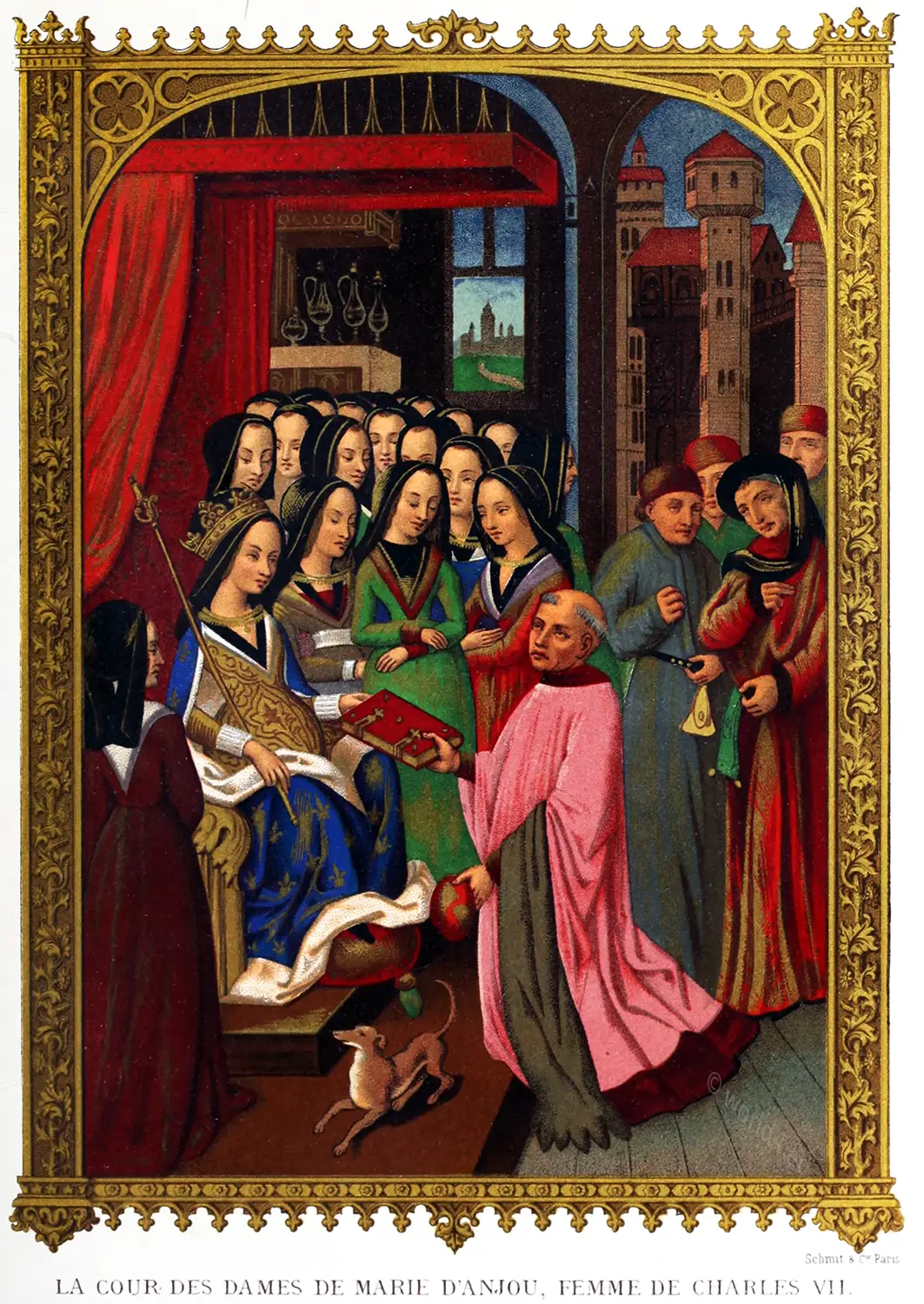
La cour des dames de Marie d’Anjou, femme de Charles VII.
Son chapelian, le savant Robert Blondel, lui présente le traité allégorique des Douze perilz d’Enfer, qu’il a composé pour elle (1455). Fac-simile d’une miniature du manuscrit de cet ouvrage. Biblioth. de l’Arsenal. Costumes du XVe siècle.
At this period Agnes Sorel was considered to be the most beautiful woman of her day. Her conversation and wit were equal to her beauty. In the Histoire des Favorites (part i. p. 103) she is said to have been noble minded full of generosity with sweetness of manners and sincerity of heart. The same writer adds that everybody fell in love with her from the king to the humblest officers. Charles VII became passionately attached to her and in order to insure her constant presence at court he placed her as maid of honor to the queen. She was the first official mistress of a French king.
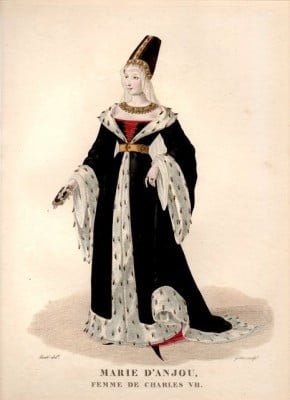
The amour was conducted with secrecy but the fact became manifest by the favors which the king lavished upon the relations of Agnes while she herself lived in great magnificence amidst a very poor court. She was fond of splendor and has been quaintly described by Monstrelet as “having enjoyed all the pleasures of life in wearing rich clothes furred robes and golden chains of precious stones and whatever else she desired.” When she visited Paris in attendance upon the queen the splendor and expense of Agnes were so excessive that the people murmured greatly whereupon the proud beauty exclaimed against the Parisians as churls.

The English were then masters of half the kingdom of France. Charles, though naturally brave, had fallen into a profound apathy in consequence of a feebleness of character which unfitted him for the struggle against misfortune. Agnes alone succeeded in recalling him to a sense of what was due to his own glory and that of his people.
Shortly after the birth of her fourth child Agnès Sorel became seriously ill. Her contemporaries called this disease as “flux de ventre”. She died on 9th or 11th February 1450 at six o’ clock in the afternoon. “How disgusting, smelly and prone we’re” have been her last words.
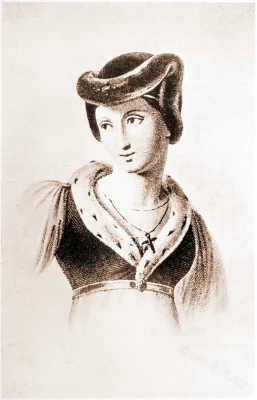
The heart and intestines of Agnes were buried at Jumièges. Her body was placed in the centre of the choir of the collegiate church of the Château de Loches which she had greatly enriched. Her tomb was in existence at Loches in 1792. It was of black marble. The figure of Agnes was in white marble; her head resting upon a lozenge supported by angels and two lambs were at her feet.
Agnès Sorel led as influential maid at the French royal court and mistress of King Charles VII. of France the fashion of the uncovered breast.
KINGS’ FAVOURITES.
by Francis Lawrance Bickley.
AGNÈS SOREL. La Dame de beauté.
Celebrity of the middle ages.
THE French Romantic Revival, with its quickened interest in things medieval, gave birth to a whole body of literature, more or less critical, concerned with the life of King Charles vn.’s most famous favorite. And in all the books which clustered round her name half a century ago, the ‘Legend of Agnes’ – as sterner historians have come to call the pretty tale- is unreservedly accepted, and Agnes Sorel accorded a place beside Joan the Maid as savior of her country.
It is a charming legend. The Sieur de Brantôme, that busy juggler with ladies’ names, got it from du Haillan, a sixteenth-century historian (Bernard de Girard Haillan c.1535–1610), and straightway enshrined it in the popular pages of the Dames Galantes. Grieved that the king (runs the tale) should pass his time in indolence or pleasure, careless that his country was ravaged and ruined by the English, Agnes pricked him from his lethargy by a show of scorn. She informed him that while still a child an astrologer had told her that it was her destiny to be loved by one of the most valiant kings of Christendom.
When Charles had loved her she thought that the prophecy was to be fulfilled, that he was the bold king foretold. But now that she saw him lazy and luxurious, and Henry of England spoiling his lands and taking his towns before his eyes, she perceived that she had made a mistake; it was in England, not in France, that she must seek her royal lover. At these words Charles fell a-weeping and ‘henceforth, shaking off his idleness, he took the bit between his teeth to such purpose that with the aid of fortune and the valour of his good servants, he chased the English out of all France but Calais.’
Although the most explicit, this is not the earliest reference to Agnes’s patriotic service. Francis I., who was dead before either du Haillan or Brantôme were in their ‘teens, had enshrined the story in a pretty quatrain, written beneath a portrait of its subject in a lady’s album :-
Plus de louange son amour sy mérite
Etant cause de France recouvrer
Que n’est tout ce qu’en cloistre peult ouvrer
Close nonnayn ou au desert Ermyte.
Surely no further explanation is needed of this neat epigram than that the owner of the album, Madame de Boisy, was the daughter-in-law of Guillaume de Goufier, Seigneur de Boisy, one of Agnes Sorel’s most intimate friends, and that Francis had a gallant fancy and a pretty gift of making verses. And Heaven forfend that we should be obliged to give credence to all that the good Brantome tells us ! Yet your sentimental pedant would implicate the destinies of two great nations in this conte of a gay raconteur, these lines of a courtly king.
Of more prosaic evidence deed or state paper give him not a scrap; and of the host of chroniclers of that much chronicled period, two only support the legend. Aeneas Sylvius Piccolomini, in the last years of his life, dictating his memoirs from the papal chair to his secretary, Gobelin, says that Agnes Sorel came to court with her mistress, Isabel of Lorraine, Queen of Sicily, who left her there at her departure. Let alone the fact that the Commentaries of Piccolomini are notoriously full of errors, there is nothing to show that, as has been presumed, he was referring to Isabel’s departure for Naples in 1435. The other chronicler, Jacques du Clercq of Arras, is more explicit.
Until the Treaty of Arras, he says, the king menoit moult saincte vie (lead many healthy lives), but that afterwards he became entangled with a young woman named Agnes, subsequently known as la belle Agnès. But, like Pope Pius, Jacques was writing long after the lady’s death, and one spies at once an inaccuracy: saincte is hardly the right adjective for the early years of Charles’s manhood. The majority of the contemporary historians, especially those most likely to know, flatly contradict this coupling of the triumph of Agnes with the Treaty of Arras. Five years is usually given as the duration of the liaison, and at her death in 1450 she is unanimously said to have been in the flower of her youth, which she certainly could not have been had she been the king’s charmer for fifteen years.
It is quite true that a remarkable change occurred in the conduct and character of Charles about the date of the treaty. At his accession in 1422 the affairs of his kingdom had been at their lowest ebb. The English were masters everywhere. Henry V. was just dead, but his brother Bedford, the regent, was proving himself a worthy successor to the hero of Agincourt. Only Touraine, Orléannais, Berry, Bourbonnais, Auvergne, Languedoc, Dauphiné, and Lyonnais recognized Charles’s authority. He was proclaimed in Berry, and bore the contemptuous nickname of ‘King of Bourges.’ At that date he was but nineteen, intellectual, sensuous, of the artistic temper, which blossomed so wonderfully in those rough times, but without the activity which stood men like Charles of Orléans and René of Anjou in good stead. Utterly disheartened, he had turned his back on his country’s need and given himself to pleasure. The chase, his gardens, and softer delights as well were his only care.
When at last, however, those bold captains, La Hire, Dunois, and the rest, from whose devotion the king won the title of ‘the Well Served,’ had given England pause, when the crowning miracle of the Maid had saved
Orléans and France, when the treaty had been signed which gave him Burgundy for an ally and Paris for a capital, Charles had shaken off his indifference, and shown himself a true if not a great king. The worthless and corrupt courtiers who had hitherto surrounded him were expelled, and he got himself wise and trusty counsellors, drawn mainly from the bourgeoisie or the lesser nobility.
He organized the wild bands of routiers (mercenary soldiers) and écorcheurs *) into an ordered army, and by the Pragmatic Sanction of 1438 laid the foundations of the liberty of the Gallican Church. The most natural explanation of this portent is that the more favorable turn of affairs had given him courage, and advancing years a sense of responsibility, the understanding that other things counted besides bread and circuses. If one must needs find a more personal influence at work, one should seek it in his patient, sensible wife, Marie of Anjou (1404 – 1463), or in his mother-in-law, Yolande of Aragon, one of the most remarkable women of the age. When the powers met at Arras the future maîtresse en titre cannot long have been out of the nursery, and when in 1444 she makes her first matter of fact appearance in history she is still in the service of the Queen of Sicily, and at a lower salary than the majority of her colleagues.
*) The Écorcheurs were one of the Grandes Compagnies, a group of demobbed mercenaries who ravaged France during the reign of King Charles VII.
Having thus ministered to his conscience at the expense of a pretty tale, the veracious and sober historian may now proceed to an account of the relations of Charles and Agnes as they really existed.
The Sorels or Soreaus were well known among the petite noblesse of Touraine. Vassals of Burgundy and Bourbon, they were none the less ever to be found following the banner of France; and though the high position to which Agnes attained was fruitful of benefits for her kinsfolk, it was from no nameless house that Charles chose his favourite. One Reynauldin Sorel had been squire of honor to the king’s father, Charles the Well Beloved, in 1416. There was an Aubert Sorel who was bailiff and captain of Chauny-sur-Oise, William Sorel was clerk of the accounts at Paris from 1436 to 1444. Geoffrey, an uncle of Agnes, rose to eminence in the Church, and, owing something doubtless to his niece’s influence, became eventually Bishop of Chalons and a peer of the realm. Her brother, Jean the younger, was made grand huntsman of France. According to Robert Gaguin, a fifteenth-century annalist, it was the sudden elevation of her relatives which first betrayed Agnes’s true position to the world at large.
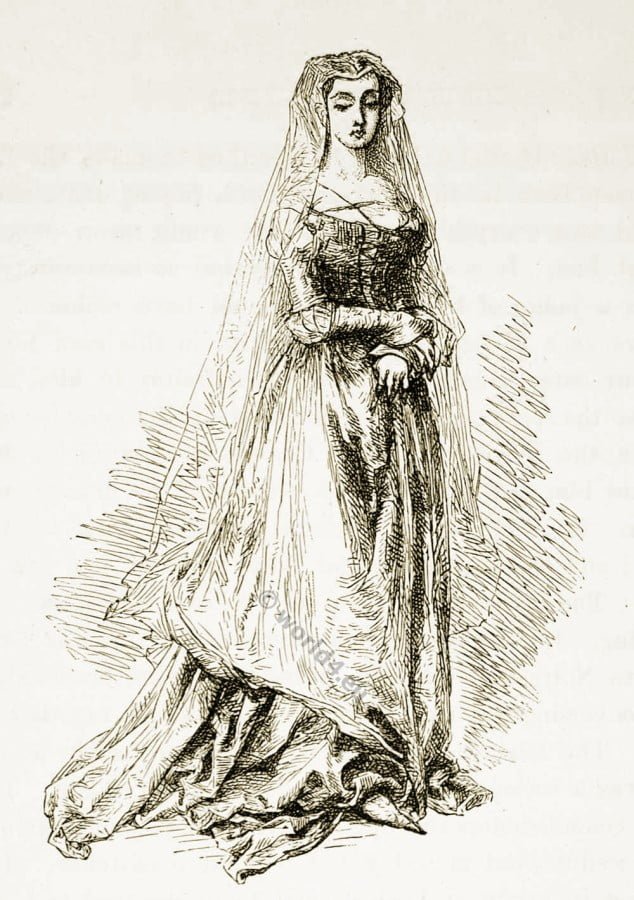
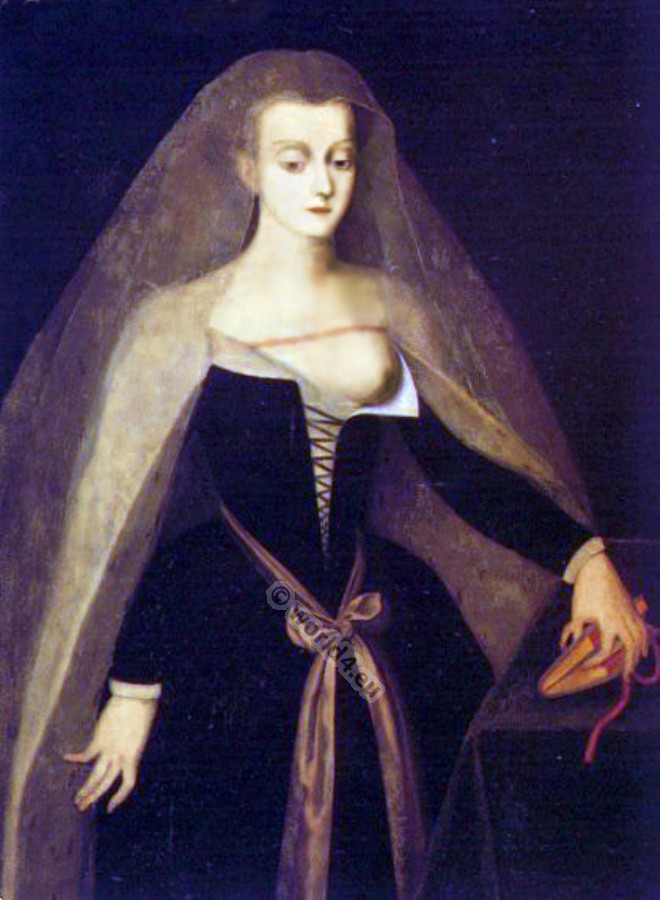
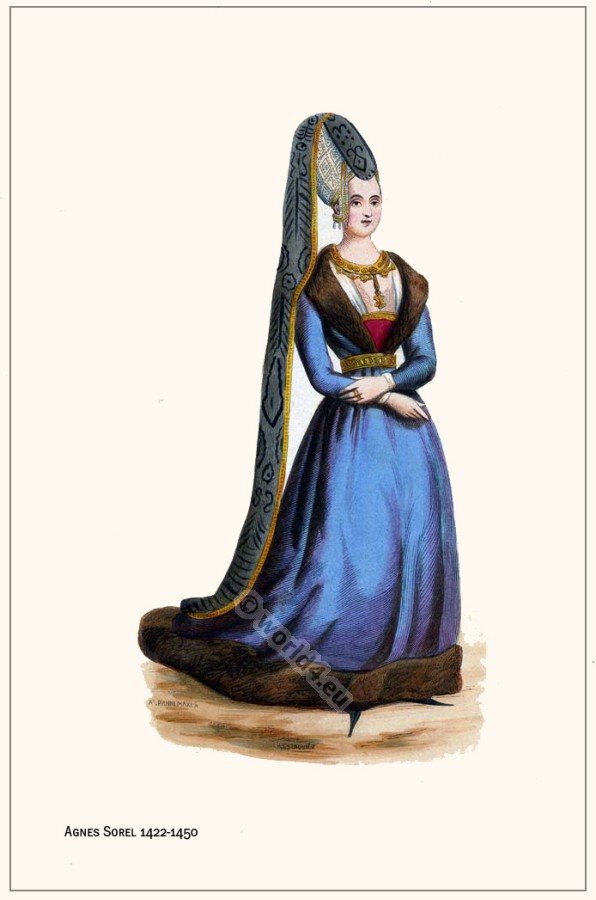
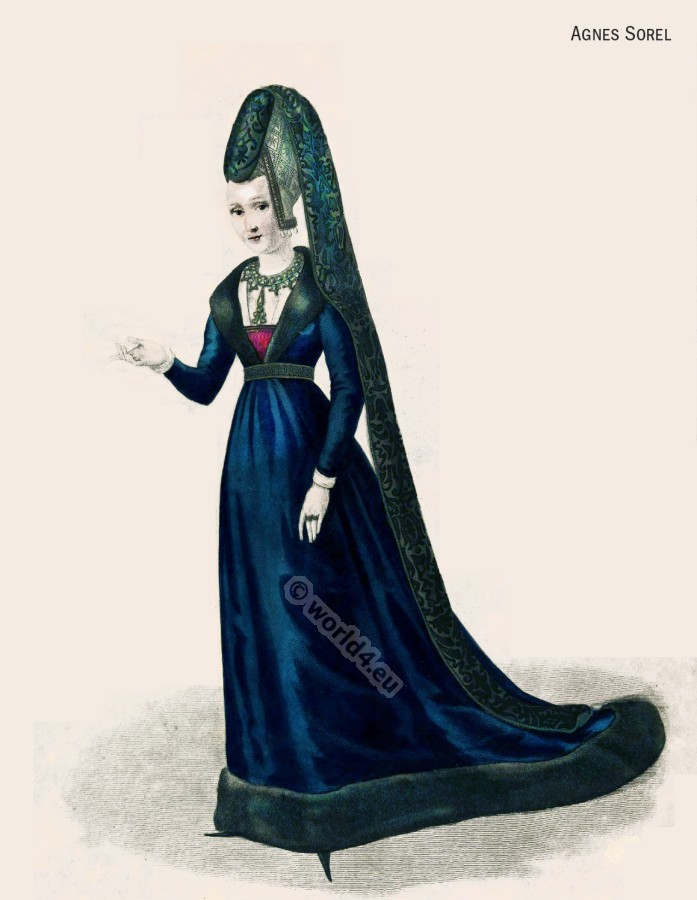
The favourite’s father, Jean Sorel, who was alive until 1446, was lord of Coudun, near Compiègne, a fief which he held of the county of Clermont in Beauvoisis. About 1425 he was counsellor to Charles I., Duke of Bourbon, at that time Count of Clermont, the son of Duke John, whom the English made prisoner on Agincourt field. He married Catherine de Maignelay, daughter of a neighboring Touranian house that also acknowledged the overlordship of the Counts of Clermont.
For a family that can scarcely claim to rank among the great ones, the Maignelays have left no discreditable mark upon the annals of medieval France. John of the name, Agnes’s great-grandfather, bore the dauphin’s banner at Poitiers (1356), and was there made captive. In London he acted as cupbearer to his king Jean le Bon, who, though a prisoner of war, found such royal entertainment as the honored guest of English Edward. Froissart has sung the praises of this John de Maignelay, under the high name of Tristan, which he assumed both for its heroic associations and because of his descent from Pierre Tristan of Maignelay, born circa 1163, who saved the life of Philip Augustus at the battle of Bouvines in 1214. ‘All men called him the good knight,’ says another chronicler. His son Raoul, father of Catherine, was of Charles VI.’s household, while Raoul’s son, another John, fought well against the Englishmen under the standard of the Maid of Orleans. In 1430, as captain of his lord the Count of Clermont’s men-at-arms, he defended Gournay-sur-Aronde against the forces of Burgundy, and later was in command of the fort of Creil,
Of the mating of these two houses was born-probably about 1422, though the supporters of the legend, uncomplimentary for once, would make it as early as I409-a girl, whose name was destined to outshine that of the most renowned of her ancestors.
Agnes Sorel first saw the light at the castle of Fromenteau, not far from Loches, on the borders of Lower Berry. From this circumstance some historians have dubbed her lady of Fromenteau, as though it were an actual title. As a matter of fact, neither she nor any of her name ever held that fief.
Of the childhood of Agnes nothing certain is known, but there is a story that she was brought up at the village of La Morinière, a kilometre east of Fromenteau. It was long said-still is, let us hope – among the old wives of the neighborhood, that Agnes, ‘que le diable et les beaux yeux d’un prince perdirent a tout jamais’ used to return sometimes at rare intervals to the home of her childhood, to embrace her old nurse. But her countenance was pale, and she loved to be alone. One day she came no more. God would not permit her.
It was the custom of the day for the daughters of gentle houses to be sent to some royal or noble court to receive instruction in the art of life, that they might in due time be fitted to play their parts as chatelaines. Accordingly, at an early age, Agnes was installed as maid-of-honour to Isabel of Lorraine (1400 – 28 February 1453), wife of Rene of Anjou, King of Naples and Sicily. She could scarcely have been put to a better school.
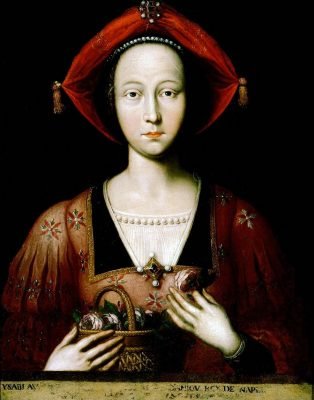
Isabella di Lorena (1400-1453), moglie di Renato d’Angiò, re di Napoli.
Isabel, a great woman in an age of great women, was the eldest daughter of Charles the Hardy, Duke of Lorraine, and his wife, Marguerite of Bavaria. From her father she inherited that high and valorous temper which stood her in such stead in the days of adversity; and from her mother, whose saintly life was filled with miraculous happenings, she got the virtue which kept her name stainless of scandal. Environment as well as heredity played a part in the moulding of her character. Charles, besides being a great warrior and a most notorious lover, was an enthusiastic patron of the arts, and legend has it that Van Eyck himself dwelt and worked at his court. It may, indeed, have been the great Fleming who first taught René of Anjou (1409–1480) the brushman’s cunning.
Be that as it may, the name of the Duke of Lorraine’s son-in-law has come down to us as standing for all that was cultured and gracious in fifteenth-century life. He was poet, musician, and painter, and none had such skill as he in the appointment of feast and tourney. Many a time, in the peaceful years that followed the Treaty of Arras, did he play the part of arbiter elegantiarum (Expert in matters of good taste) at the French court. Artist by nature, he was of necessity also a man of the sword, as one who wore a crown and purposed to keep it had need to be in those turbulent times of disputed succession. To René came more than one crown, and much fighting.
Duke of Bar by inheritance, his wife brought him the duchy of Lorraine, which Charles the Hardy, finding himself old and without hope of sons, had declared a feminine fief. No sooner, however, had René and Isabel mounted their throne, than Antoine de Vaudemont, René’s cousin, urged his claim, fought and vanquished the new duke at Bulgnéville, and cast him into prison. One may read at length in the great chronicle of Monstrelet how Rene, with arms and nose and lips wounded, set his back to a tree and fought like a common soldier who set not a button’s value on his life. This was in 143I, and it was not until 1437 that Rene regained his unconditioned freedom. Like his more famous cousin, Charles of Orleans, he was poet, prince, and prisoner of war.
All this may appear to have little to do with Agnes Sorel, but it really had no small bearing on her life. During Rene’s captivity, Isabel took the management of his complicated affairs into her own hands. After Bulgnéville, and even before she knew the result of the battle, she had presented herself to her husband’s counsellors, a tragic, blackrobed figure, leading her children by the hand. ‘Alas!’ she cried, ‘I know not whether my husband be dead or taken.’ The lords of Lorraine had risen as one man, and sworn to defend her.
Meanwhile, under the will of Joan II., René had inherited the kingdoms of Naples, Sicily, and Jerusalem; and the duchy of Anjou. This is no place for a discussion of tangled dynasties. Suffice it to say that here it was Alfonso of Aragon who set up a counter claim, and that in 1435 the dauntless Isabel, at René’s bidding, started for the south, not to set eyes on France again for some six years.
With her went Agnes Sorel, her young maid-of-honour, and there, in the warm south, grew from girlhood to womanhood, ripening into that beauty which was soon to bring her royal if unhallowed homage. Her charm is said to have early won the special favor of her mistress, who loaded her with presents, and kept her constantly about her person. According to the chronicler, Jean de Bourdigné, she was treated like a princess and left Isabel’s service a rich woman. In face of the poverty of the court of Lorraine at this date, this seems a little doubtful.
In 1441 René and Isabel returned at length to France. They spent nearly two years in setting their affairs in order in Lorraine and Provence, and it was not until early in the spring of 1443 that Isabel went to pay her respects to the king and queen, who were at Toulouse.
At Toulouse, then, and in the springtime, Charles VII first saw the beautiful Agnes Sorel, and then and there was engendered, if not born, their famos intimacy. In April, however, Isabel and her retinue removed to Saumur, and the incipient love-affair had no chance of making progress during the long summer months. But in September the king, perhaps because of his love-hunger, followed the Lorrainian Court, and at Saumur spent the winter. From that period dates the real commencement of Agnes’s supremacy. In July 1444 she was still on the list of Isabel’s household, but at a salary so small as to suggest that her duties there had come to be recognized as purely nominal. By the end of the year she had been completely transferred to the service of Queen Marie.
At this date Agnes Sorel was about twenty-two years old, and extraordinarily beautiful, a blue-eyed blonde, with a wealth of hair, a wonderful smile, and exquisite teeth. Friends and enemies are unanimous in praise of her charms. ‘Fairest of the fair,’ one calls her. ‘Fairest and youngest in the world,’ ‘the most beautiful young woman that one might see at that time,’ ‘one of the most beautiful women I have ever seen,’ such were the testimonies of her contemporaries. Pius II. speaks in superlative of her lovely face, and even Thomas Basin, Bishop of Lisieux, who did not love her, is constrained to call her ‘a pretty little woman enough.’ ‘Like unto the flowers of springtime was the face of this woman.’ So ran her epitaph. With whimsical and characteristic gallantry Charles’s first gift to his new mistress had been the château of Beauté-sur-Marne, so that her right to the title of Lady of Beauty was doubly assured. One of the earliest records of her is a silver statuette at Loches, with the following inscription: ‘In honour and reverence of St. Mary Magdalen, the noble lady, the Lady of Beauté, has given this image to this church of the Castle of Loches, in which image is enclosed a rib and hairs of the said saint; and it was the year 1444.’
The king himself was no more than forty when he met Agnes, and probably looked younger, for he was a slightly built man, not exactly handsome, but with something of the melancholy charm of a Hamlet. His legs were thin, we are told, and he showed better in the long robes of ceremony. He was self-absorbed and reserved, a lover of solitude, shy in the presence of strangers. Publicity he hated, and shrank from the glamour of court and camp. Always courteous and gentle, he loved the soft ways of women, and, open as he was to impressions, it is natural that those with whom he was on terms of intimacy should have exercised a powerful influence on his character. It is certain that those strong women Yolande of Aragon and Isabel of Lorraine were to some extent responsible for the energy and kingliness which marked these middle years of his reign, while the queen, with her less pronounced virtues, was scarcely less useful than they. Agnes, too, if she must be shorn of the glory with which indiscreet enthusiasts would dower her, may be credited with a certain beneficial effect. After the years of her sway Charles’s vice was indiscriminate and incoherent; but to Agnes he remained faithful.
The amour once publicly known, there was no attempted concealment of her importance. She was the first of that long line of mâitresses en titre who enliven the pages of French history. The king delighted to honor her, and the tale of her lands and houses was increasing at her death.
Beauté-sur-Mame has already been mentioned as the first chateau to be bestowed on the favourite. An ancient royal residence, according to tradition, situated near the wood of Vincennes, it was’ le plus bel chastel et joly et le mieux assis qui lust en l’Isle de France.’ To this was soon added Rocquecezière in Rouergue, which two members of the royal house had recently held. Charles had given it to his son, Louis the Dauphin, in 1440, but had soon taken it back to give to Louis de Bourbon, Count of Vendôme. The count died in December 1446, and Agnes had Rocquecezière. The châtellenie of Issoudun also appears to have been given her, at least she is styled Lady of Issoudun in various records, and in the last months of her life she had a grant of Vernon-sur-Seine, which Dunois had just snatched from the English, in whose hands it had been for thirty years. Dowered with these and an annuity of three thousand pounds, Agnes was able to hold her head high among the greatest in the land. Though she had none of the rapacity which distinguished an Alice Perrers or a Barbara Villiers, the impoverished coffers of France must have found her maintenance no slight tax.
Besides these houses which Agnes had by royal gift, there were many others at which she sometimes stayed. The five or six years of her favour were years of comparative peace and relaxation. There was truce from fighting and, his ecclesiastical and military reforms well in hand, the king was resting from his sudden labors. He passed most of his time at Chinon or Loches, which seem ever to have been the residences of his predilection.
There was, and still is, a tower of the castle of Chin on called the Tour d’Argenton. From this there was a secret underground passage communicating with a house outside the walls known as Roberdeau. At Roberdeau dwelt Agnes, and it was probably there that, after the departure from Saumur, and before the state of affairs was known to the world at large, the royal love-story developed itself. Other houses in the same neighborhood are associated with the favorite’s name. Candes, a hunting-lodge, where Charles was in 1446, Amboise, Razillé, and Le Plessis, whence Agnes dated letters, are none of them far from Chinon. Near the castle of Usage, hard by Tours, a favorite pleasure-house of the king’s, he built her the pavilion of Bonaventure, whither, tradition has it, he would often repair of an evening to spend the next day in the delights of the chase.
A similar story is told of Bois-Brousseau, near Melun in Berry. At the approach of night, Agnes would light a fire on one of the towers, and her lover, simply clad and alone, with only his sword to protect him from sudden danger, would soon be knocking at the gate. In Touraine, again, is still standing the castle of Fontenailles, another claimant of the honor of having housed the ardent pair.
When not at Chinon, Charles would be at Loches, and over two houses near that town the name of Agnes Sorel has cast the glamour of romance. Beaulieu, a little place joined to Loches by a series of bridges over a branch of the Indre, still stands, though with nothing but a little tarnished gilt and peeled fresco to bear witness to its ancient glory. A little further a field is La Guerche, built as a hunting-lodge by Charles for his mistress. To this day the fantastic figures on the frescoed walls speak of the chase, which both so greatly loved.
The chroniclers disagree completely as to the queen’s attitude towards her supplanter. Their views are obviously colored by their own feelings in the matter. One historian states that Marie welcomed Agnes, who at least sustained her difficult position with dignity, as a positive blessing after the promiscuous beauties of earlier days. According to another version she was merely meekly resigned, while the obvious tears of humiliation are, of course, assigned to her.
The Burgundian chroniclers, Olivier de la Marche and Georges Chastellain, who exhibited a peculiar animosity towards Agnes, are the most indignant on the queen’s behalf. In July 1445 the Duchess of Burgundy came in state to visit Charles. Her errand was a political one, but there were other matters discussed in the privacy of the queen’s chamber. So, at least, says Olivier, and he has the credit of being well informed. ‘And ye may well believe’ he writes, ‘that they had a common woe and sickness which is called jealousy, and many a time they confided their passion to one another in secret; and this was the cause of their intimacy. For the king had but lately raised up a poor damsel, a gentlewoman named Agnes Sorel, and set her in such triumph and power that her estate was like to that of the great princesses of the land.’
But Olivier was evidently more than half inclined to excuse the king’s aberration from the paths of conjugal fidelity. ‘And in sooth,’ he goes on, ‘she was one of the fairest women that ever I saw, and did in her way much good for the kingdom of France. She introduced to the king’s notice young gentlemen of arms, by whom he was afterwards well served.’
Chastellain, on the other hand, court historian to Duke Philip the Good, and a vigorous partisan of Burgundy, attacks the favorite of his master’s suzerain with a quite extraordinary rancour. ‘A brazen woman,’ he calls her, ‘a poor serving-woman of mean condition, whom the queen for the sake of peace and quiet suffered not only to live with her, but to keep a better estate than herself.’ But when he goes on to accuse Agnes of corrupting the morals of the women of France and Burgundy, we begin to grow suspicious of his impartiality. Such a statement is too disingenuous, coming from one who served the good Duke of Burgundy, husband of that duchess whose tears are so pathetically pictured as mingling with those of her queen. For Philip’s twenty-four mistresses are known by name to posterity, and the scandals of his court were notorious.
The truth seems to be that Marie, who had none of her mother Yolande’s greatness or her brother René’s brilliance, who was neither beautiful not witty, was dowered with the only possible compensation, a philosophic temper. She is a shadowy figure at all times on the pages of history, appearing only as the mother of many children, and perhaps the influence that she exercised over the king has been exaggerated. As often as not, in these years of perpetual change, her residence was far from his. She always had her own separate household.
It is quite probable that she liked Agnes. She at least accepted her as maid of honour without a murmur. There is no record of vulgar scenes such as took place between Charles II. of England and his unfortunate Portuguese spouse, when the king wished to force Lady Castlemaine into a similar position. But then Charles of France was a gentleman, and he always behaved as one towards Marie. If he did not pretend to be faithful, he was generous and considerate, and many gifts which he made to his wife are on record. A pious woman, she spent much of her time in going on pilgrimage; a great reader, one may still mark how, as time went on, romances of chivalry gave place to moralities, and these to books of devotion. She outlived the king, and died in 1463, in her sixtieth year, on the eve of a long projected pilgrimage to the East.
Whatever Georges Chastellain or other detractors might say of her, Agnes was undoubtedly a great success. Where ever the court might be held, in these years of truce, tourney and pageant were the constant order of the day. Young, rich, of no mean birth, the most beautiful woman in the land, the ‘lady of Beauty’ presided as queen of the lists, and hope of a smile from her eyes must have pressed many a lance harder home. At the wedding of Henry of England and Marguerite of Anjou, René’s daughter, she was a maid of honour, and rode in the garb of an Amazon, a wonderfully wrought suit of armour glittering with jewels, and seated on a charger only less richly dight than herself. In dress she set the fashion, and, according to her enemies, neither her own modesty nor the innocence of men was the end aimed at in the style of her raiment. About this time the cutting of diamonds was introduced, and Agnes is said to have been the first to wear the new ornament, in a girdle presented her by Jacques Coeur, who is one of those credited with the invention. To her example, also, and Isabel of Bavaria’s was due the wearing of linen undergarments. ‘She was better tended than the queen,’ wrote the spiteful Burgundian, ‘with a more numerous court, fairer bedfurniture, fairer tapestries, better linen, kitchen and plate superior to hers.’ Her influence was paramount. It was of no mean advantage to be her friend; and a certain Pierson Sureau, who had been condemned to death for attempted suicide, was pardoned merely on the ground of his being her compatriot and namesake.
Agnes’s friendship, however, was not sought merely for the advantages it might bring. Her attractive personality gave her disinterested well-wishers in plenty, many of whom stood above the need of her helping hand. She was the intimate friend of some of the most distinguished men at court, and it is greatly to her credit that she was nothing more. She has indeed been accused of being the mistress of Etienne Chevalier, a distinguished ambassador and treasurer of France; but there is only an isolated, probably malevolent, reference to such a liaison, and everything tends to show that she remained faithful to the king. In fact, Jean Chartier, a younger brother of Alain the poet, whom a queen kissed in his sleep for his beautiful verses, goes further than that, and is ready to vouch for her innocence even of royal favour. To this clean-living monk of St. Denis the whole thing was a base scandal. ‘And because the said Agnes had been in the service of the queen for the space of five years or thereabouts, during which time she had had all sorts of worldly pleasures and all the pastimes and joys of the world, to wit, the wearing of great and extravagant head-dresses, pretty frocks, furs, necklets of gold and precious stones, and the enjoyment of all her other desires and pleasures like one who was young and fair, therefore it was common report that the king maintained her and kept her as his mistress. For nowadays the world is more prone to think and speak ill than well.’
In his desire to get at the truth, the good monk had made close inquiry among knights, squires, and counsellors, physicians and surgeons, and settled the question entirely to his own satisfaction and the lady’s credit. It was all the queen’s fault, who insisted on her living in such suspiciously grand style. As for Agnes, she had never been seen ‘toucher par le roy au dessoubz du menton.’ Perhaps her lover was too respectful. Probably he did it when there was no one to see. Any way, there are the four daughters whom Jean fails to explain away.
To return to the friends of Agnes. Not the least distinguished was Jacques Coeur (1395-1456), who from being a simple merchant rose to be the king’s most trusted counsellor. His commercial enterprises brought him an enormous fortune. This he put absolutely at his country’s service, and he financed the Norman expedition of 1449. His generosity and power at last aroused the jealousy of the nobility, and in 1450, just after the death of Agnes, he was brought to trial on various charges, the most preposterous of which was that of having poisoned the favorite, whose friend and executor he had been. Although this accusation fell to the ground, others were deemed proven. He was cast into prison at Beaucaire, and his riches divided among his enemies. Escaping from prison by the aid of his former clerks, he made his way to Rome, where the Pope received him with honor, and lodged him in the Vatican. He died in 1456, from a wound which he got when fighting against the Turks at Chios. His hotel exists at Bourges. It is decorated with elaborate and symbolic carving. One of the figures is supposed to represent Agnes.
Agnes Sorel’s most intimate friend, one who owed her his prosperity and shared, to some extent, her fortunes, was Pierre de Brézé (1410-1465), seigneur de la Varenne. Ranking by birth among the lesser Angevin nobility, De Brézé makes his first appearance on the public scene in 1432, when he acted as agent of Charles of Anjou and the Constable Richemont in their overthrow of the king’s minister, Georges de la Trémouille, whose iniquities they judged the country to have too long suffered. Knighted by Charles of Anjou two years later, and appointed seneschal of Poitou in 1441, it was not until the end of 1443 that he made his entry into the central government. Here can clearly be traced the influence of Agnes, who must have known Pierre at the Angevin court. He was one of the ‘young men of arms and gentle companions’ who, according to Olivier de la Marche, were introduced to Charles by his favorite, and afterwards did him good service.
From that time onwards until the end of the reign Pierre de Brézé played a prominent part in the political world, having a hand in the military and financial reforms and all the other important matters of the day. With Agnes he shared the intimacy of Charles, and a warm friendship and sense of comradeship existed between the two favorites. Of the five letters written by Agnes Sorel 1) which have survived, two are addressed to De Brézé.
‘Monsieur mon compere,’ she writes, signifying either that De Brézé was godfather to one of her children, or that together they had stood sponsors at some, perhaps royal, christening.
‘I commend myself to you in as special a manner as possible, for a man named Mathelin Tiery, who is father of one of the maids of my household, has complained to me that a rent, which he has been wont to receive on a butcher’s shop in the town of Chinon, and which amounted to twenty-two sous, was scarcely improved on the occasion of the late war, and is now worth no more than sixteen sous; which, added to the little that remains to him, does not permit him to live, and he is fallen into great poverty.
1) It must be confessed, with whatever reluctance, that the authenticity of these letters, at one time proclaimed with enthusiasm, is by later and more critical historians declared doubtful.
The said Mathelin begs that you will be good enough to accord him and condescend to give him a post, which was promised him by your squire, Guionnet, which would come to him most conveniently for his maintenance. And so I would pray you accord it and condescend therein, which would thus come to the said Mathelin as an indemnity for having been so hardly treated in the matter of his said rent, and you will give me much pleasure by hastening therein. I pray to God, monsieur mon compère, that he will give you your desires.- From Cussay, the penultimate day of April.- Your entire servant and commère, AGNES’
In August-both letters probably belong to 1446-she wrote to him from Amboise touching a certain matter of respited homage which she begs De Brézé will settle for her.
‘An adventure has befallen us’ (she goes on) ‘of a man who, it is said, was a ruffian and scoundrel and became acquainted with one of the women and entered the house by night, where by the aid of the tools of a thief he took in a box some jewels and reliquaries, which had been left with the said woman to be looked after. And getting away he fell in jumping a ditch, where he was taken; and they say that it was because of the reliquaries that he was thus captured.’
Her other letters all bear witness to that kindliness towards man and beast which was Agnes’s great virtue. Two of them are to Mademoiselle de Belleville, the daughter of Charles VI. and Odette de Champdivers, and show that there must have been a considerable degree of intimacy between the two women. One is written from Razillé, the other from Candes.
‘MADEMOISELLE,- My good friend,- I commend myself to you with all my heart. I pray you be good enough to give this bearer, Christophe, my dress of grey doubled with white and all pairs of gloves that you find in my lodging; the said Christophe having lost my glove-box wherein I had brought a number. Further will you please accept from him my greyhound Carpet, and will you keep him with you; for he obeys neither whistle nor call; wherefore I send him back, and he would otherwise be lost, which would be a great grief to me.’
The second letter to Mademoiselle de Belleville, written about the same time, deals also with sporting matters.
‘MADEMOISELLE,- My good friend,- With all my heart I commend myself to you. Please to know that I marvel much at the report which you have sent me by young Dampierre,1) and I send him back to you to help you out of the great ennui, in which you must have been. We are enjoying ourselves as well as we can in these quarters and you ought to come as soon as possible that you may be out of the said ennui; which will be very soon indeed, I hope. Meanwhile, yesterday we hunted a boar, of which your little Robin had found the trail; and the said hunt went badly for the said little Robin, as he was struck by a stone which one of the huntsmen threw at the said boar in a thicket; and he was badly enough wounded by it. But I hope that he will be cured without delay and I shall have him well looked after. Meanwhile, if there is anything else I can do for you, pending your coming, let me know and I will do it very willingly.’
The last of Agnes’s epistles is to the provost of La Chesnaye.2)
‘I have heard that certain persons of the parish of La Chesnaye have been summoned by you, on suspicion of having taken certain wood from the forest of the said place and that a day has been appointed to hear an information laid against their innocence. Whereon having learnt that some of the said folk are poor, unfortunate persons, and that they are at great pain to earn a living for themselves and their wives and children, I wish that no further steps be taken with regard to the said information and days, and that the said folk be in no way detained, either their persons or their goods; but that the said affair, on the contrary, be nullified; and in doing this without delay you will do me an agreeable service. Praying to God, monsieur le prevost, that he will give you a good life and have you in his keeping.- From La Plessis, 8 June.
Your good mistress, AGNES.’
1) Francis de Clermont, Seigneur de Dampierre, master of the queen’s household in 1456.
2) ? Fresnaye.
One result of her friendship with Pierre de Brézé was what seems to have been the first and only visit which Agnes ever made to Paris. Early in 1448 Charles VII. went on a punitive expedition to Le Mans, whose English captain, obstinately and in direct violation of the agreement between the nations, had refused to remove his garrison. Starting from Tours, the king held a council at Lavardin, near Le Mans, 6 March, and thence and from Montoire, another neighboring manor, he directed operations. With him was De Brézé, who flitted continually from court to camp. Probably Agnes was there too.
At all events, after the ten days’ siege, they all found themselves at Tours again, where they celebrated Easter. On 28 March, irritated by the charges which were constantly being made against him, principally at the instigation of the mischievous dauphin, ever so ready to embroil his father with his servants, De Brézé voluntarily gave himself up to justice. He besought Charles that he might be put on his trial before the parliament, and for that purpose was conducted to the capital.
A month later Agnes set out for Paris, accompanied by the king’s squires, Guillaume Gonfier and Poncet de Rivière. She travelled in great state. According to a household account of that date, the end of this journey was a pilgrimage to the shrine of St. Geneviève of Paris. This, however, was probably only a pretext.
We know that Agnes was pious, and generous to at least one religious foundation; but there is no other record of her going on pilgrimage. This was almost the only occasion on which she left Charles’s side, and the only one on which she figured as the centre of a state journey. That it should have coincided so closely with the peril of her friend can scarcely be accidental. She left Paris 10 May, and four days later De Brézé was acquitted. There can be little doubt that the Lady of Beauty had cajoled the judges.
In Paris Agnes does not seem to have made a good impression. Her position and the luxury with which she maintained it were alike shocking to the citizens. She is reported to have been dissatisfied with her reception, and to have called the good people uncomplimentary names, saying that if she had known she should be received with so little reverence she would never have set foot in the place.
‘Which would have been no great loss,’ comments the Bourgeois de Paris, and adds, with characteristic bourgeois virtue: ‘So departed the fair Agnes, the tenth day of May following, to her sin as before. Alas! what pity when the head of the kingdom gives so ill an example to his people.’
The one person, among those in high places, who really hated Agnes, was the dauphin, afterwards to be, as Louis XI, one of the most famous of all French kings. This animosity did not always exist. Shortly after the favourite’s appearance at the court he presented her with some tapestries, woven with the story of Susannah and the Elders, which were part of the spoils of his expedition against the Count of Armagnac. It was not long, however, before a quarrel occurred. The prince was devoted to his mother. Agnes said some slighting word of her, or Louis thought she did. According to one account he boxed her ears, according to another he drew his sword on her. From this time forward he was her declared enemy. Since the Praguerie of 1440, the revolt by which he had shown his disapproval of the new military regulations, the Dauphin had been on fairly good terms with his father.
When, in 1445, he broke out again, he alleged the ascendency of Agnes as his excuse. In the following year, informed of a plot against his life, Charles banished his son to his own domains. There he dwelt almost as an independent sovereign, making his own wars and his own laws. He never saw the court again, until he returned to it as king. He had thus no further opportunity of prosecuting the hatred which he felt for his father’s mistress, and the charge of poisoning her, which historians have been pleased to level against him, is absurd. N one the less he was in a partial and indirect manner the cause of her death.
The siege of Le Mans, referred to above, was the beginning of the final rupture of the truce with England. The expelled garrison, seeking a new abode, had forcibly occupied Saint James de Beuvron and Mortain, on the frontiers of Normandy and Brittany. The garrison of Verneuil sacked the prosperous Breton town of Fougères. Somerset publicly disavowed the action, but refused to give satisfaction to the Duke of Brittany. The French nobles demanded war.
This, after sundry formalities and conscience-salves, Charles gave them. At a solemn assembly held at the castle of Roches-Tranchelion, near Chinon, 17 July 1449, the truce was officially declared broken by the king, the princes of the blood and the members of the Grand Council. In the following month Charles led his army into Normandy, leaving wife and mistress in Touraine.
Early in January 1450, when Marie of Anjou moved to the castle of Melun, Agnes Sorel took a step which cost her her life. Instead of going with the queen, she set out to find Charles. In the heart of winter, in expectation of the birth of a child, she started on the long and dangerous journey from Loches to the seat of war. Her motive must have been a strong one. It is supposed that she had got wind of a conspiracy of the Dauphin. There is no actual evidence that such a suspicion was well grounded, but Louis’s conduct at this time might-well give rise to uneasiness. He had refused to take any part in the Norman expedition, and preferred sulking in Dauphine, where his rule was equally unsatisfactory to his neighbors and his subjects. He kept up a clandestine correspondence with Burgundy, and within a few days of his father’s setting out for Normandy had entered into a league with the Duke of Savoy against the ministers of France.
Agnes found the king besieging Harfleur. His victorious campaign had put him in good spirits, and when he heard her anxious errand he only laughed.
A lodging was found for her at the abbey of Jumièges. There, weakened by her journey and her approaching confinement, she fell sick. She was removed to the neighboring manor of Mesnil, a farm or pleasure-house of the abbots. There, on 9 February 1450, after giving birth to a daughter, she died. ‘During her sickness she made right fair contrition and repentance for her sins, and often minded her of St. Mary Magdalen, who was a great sinner of fleshly sin, and devoutly called on God and the Virgin Mary to her aid. And, like a true Catholic, after receiving the sacrament, she asked for her Book of Hours, that she might say the verses of St. Bernard, which she had written with her own hand; and afterwards she made many bequests, which were put in writing to the end that they might be carried out by her executors with her testament. And they amounted, both for alms and for paying her servants, to the sum of sixty thousand crowns.’
As her sickness gained on her and she knew herself near death, she spoke to those around her, Monseigneur de Tancarville, Madame de Brézé, Gonfier, the king’s squire who had accompanied her to Paris, and her maids. Our frailty was a little thing, she said, and impure and corrupt. Then she requested her confessor, Master Denis, to give her absolution, and a little after, about six o’clock in the evening, she uttered a loud cry, called on the name of the Virgin, and passed away.
It is Jean Chartier who tells the tale of these last hours of the woman whom he so much admired and pitied; and, unswerving from his chivalrous attitude, he attributes her death to chagrin at the scandalous and unfounded reports which besmirched her fair name.
Agnes appointed as her executors Robert Poitevin, her physician, Jacques Coeur, and Étienne Chevalier, and as overseer the king. Her will has not been preserved in its entirety, but she must have had much to leave. Her jewels alone, which Charles afterwards purchased with money borrowed from Jacques Coeur, were worth twenty thousand six hundred crowns. She left five hundred crowns to her younger brother André, and the abbey of Jumièges and the collegiate church of Loches both benefited.
At Jumièges she made provision for daily requiem and yearly obit. Loches had always enjoyed her special favor. In 1444 she had given to that church a silver statuette of St. Mary Magdalen and a cross of gold, designed to encase a piece of the true cross, the gift of Fulk the Black, Count of Anjou. Some years later she conceived the desire to endow four choir-boys and a choirmaster there. On the day of her death this foundation had not been completed, but the king subsequently confirmed it. By her will she gave the canons two thousand crowns, and until the suppression of their church they continued to pray for her soul.
To these two churches belonged the honor of housing her remains. Her heart was buried at Jumièges, the rest of her at Loches. At both places Charles entrusted to Étienne Chartier the duty of erecting sumptuous tombs. That at Jumièges, destroyed in the religious wars of the sixteenth century, was of black marble, surmounted by a white marble statue and graven with Latin epitaphs. The tomb at Loches, for which Jacques Milet, the court poet, wrote one of his most famous poems, is still in existence, though moved from its original site and most deplorably restored after the ravages of the Revolution. In her epitaphs Agnes, who during her life remained a simple maid of honour, is styled duchess.
In the following reign the ungrateful canons of Loches wished to do away with the tomb of one whose life had been so little in accord with the precepts of Holy Church. They applied to the king for permission. Louis’s reply was as spirited as it was unexpected. ‘I consent,’ said he, ‘but you must also give up her gifts and legacies.’ The tomb remained where it was.
Agnes bore her lover four daughters, of whom the youngest, the cause of her mother’s death, lived but six months. The others all grew to womanhood. Charlotte, acknowledged fille de France, and probably the eldest, became the wife of Jacques de Brézé, son of her mother’s friend. This marriage, which was made by Louis XI. for his own purposes, was not a fortunate one. Charlotte proved faithless to her husband, who took summary vengeance with the sword.
Marie de Valois was from her infancy brought up at the castle of Taillebourg (now Charente-Inférieure) by Prégent de Coëtivy, admiral of France, whose brother, Olivier, Count of Taillebourg, she married in 1458. She was the author of some charming letters, which have been published. Her sister Jeanne married Antoine de Bueil, son of Jean de Bueil, author of the romance called Jouvencal, which, in the form of fiction, gives an interesting picture of the times. She seems to have been a special favorite with her half-brother, Louis XI.
From the death of Agnes Sorel dates the moral deterioration of Charles. Scarcely was she in her grave before he began to show favor to Antoinette de Maignelay, her own cousin, whom Agnes, ever anxious for the good of her relatives, had brought to the court. Antoinette, whom the king married to an old gentleman named André de Villequier, displays the worst, as Agnes perhaps the best, type of royal mistress. She robbed the treasury, intrigued with the Dauphin, and carried on an amour with Francis II., Duke of Brittany. To do her justice, she was not jealous. She discovered a profitable occupation as mistress of the royal harem. ‘Wherever the king went,’ writes Thomas Basin, ‘there a troop of women, dowered and dight like queens, must follow him.’
Source:
- Kings’ favourites by Francis Lawrance Bickley. London: Methuen 1910.
- The lady of beauty (Agnes Sorel) by Frank Hamel. London: Chapman and Hall, 1912.
- Mœurs, usages et costumes au moyen âge: et à l’époque de la renaissance by Jacob, P. L. Paris: Firmin Didot, 1874.
- Agnès Sorel, et Charles VII; essai sur l’état politique et moral de la France au 15e siècle
- Agnès Sorel, et Charles VII; essai sur l’état politique et moral de la France au 15e siècle par François Frédéric Steenackers (1830-1917). Paris Didier, 1868.
Continuing
Discover more from World4 Costume Culture History
Subscribe to get the latest posts sent to your email.

